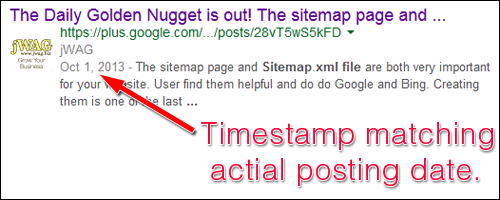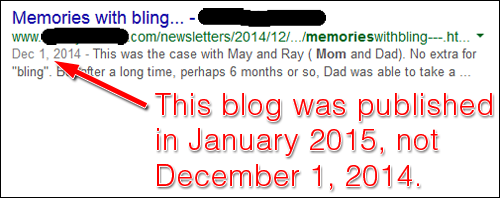
Every week, I receive at least one question from my readers through Facebook, Twitter, comments on jwag.biz, and even direct emails. Sometimes I reply privately, but sometimes I use those questions as source material for future Nuggets, like this one.
Here's a question that arrived via email about a week or so ago:
Regarding Blogging... Can post-dating a blog that you "should've" written months ago help you now if you date it the date from before (i.e. it's Feb and the blog you mark as November 16th)? What's the cut-off date?
That's a great question, and I believe I understand why it's being asked. Timing your online content can be an important part of online marketing, and sometimes the content is useless if published too early or too late.
For the purposes of directly answering this question I will assume that the person asking is interested in the effects of content building rather than trying to carefully time their blogs with other marketing.
First of all, be it known that Google records a timestamp whenever they find new content. They use this timestamp to determine who originally publishes content and then who might be copying it in the future. This is how Google knows if you've plagiarized too much direct content from someone else's blog post.
Google's spiders are not perfect and they don't always find all the content on a website. Try as hard as they might, they will usually miss a few pages if you don't include them all in your sitemap.xml file.
I originally published that Sitemap Nugget on October 1, 2013 and it was shared to Google+ that same day. Here's how it appears in Google SERPs with the actual date it was published:

Google correctly shows the publication date of the blog and the social media share date. They happen to be the same date.
Some readers might be interested in a more up to date article than one that was published 16 months ago. In fact, Google gives you the ability to search for more recent blogs in their advanced search tools.
Google doesn't publish their internal timestamp records, so we'll never know when they first read a page. What I do know for sure is that they will publicly display the timestamp that you assign your blog posts.
Take a look at this next screen shot:

Although the above image shows a publication date of December 1, 2014, I know for a fact that the actual publication date was January 12, 2015 at 4:25PM Eastern. In early January, this particular jeweler asked us to upload their December newsletter. Because it was a holiday seasonal newsletter, it didn't make any sense to tag it with dates in January, so we back-dated it to December.
The date showing in the Google SERP shows the date as published on the page, and in the URL, instead of the date Googlebot first crawled the page.
Although the holiday newsletter might not contain valuable information for right now, I've measured cyclical patters in page session counts that repeat every year. That post-dated newsletter from December 2014 will probably gain popularity in December 2015, and every December thereafter. Why? Because that holiday newsletter also contained many holiday related keywords.
Another thing about timestamps is that more savvy users will use them to see how up-to-date your website is. Updated blog timestamps will often lead people to believe that your online product catalog is also up-to-date; whereas 6-month old or older timestamps usually carry the stench of a rotting website that's not being maintained.
Key Takeaways...
Website visitors want to know that your website is updated regularly, rather than being abandoned. The back-dating technique can be employed to give your readers the appearance of ongoing activity, but it's always better to have actual continual activity.
Google likes to find new information on your website regularly. That regular schedule will keep Googlebot coming back to your website more often. As they find new information on your site they will eventually include your pages in the search results more often too.
Have a question of your own?
Feel free to send your own question through any of these methods:
* Post a comment on jwag.biz
* Send a question using this form: http://www.jwag.biz/contact-jeweler-website-advisory-group.html
* Engage with me here: https://plus.google.com/+MatthewPerosi/
* Post a question to me on Facebook: https://www.facebook.com/matthewperosi








